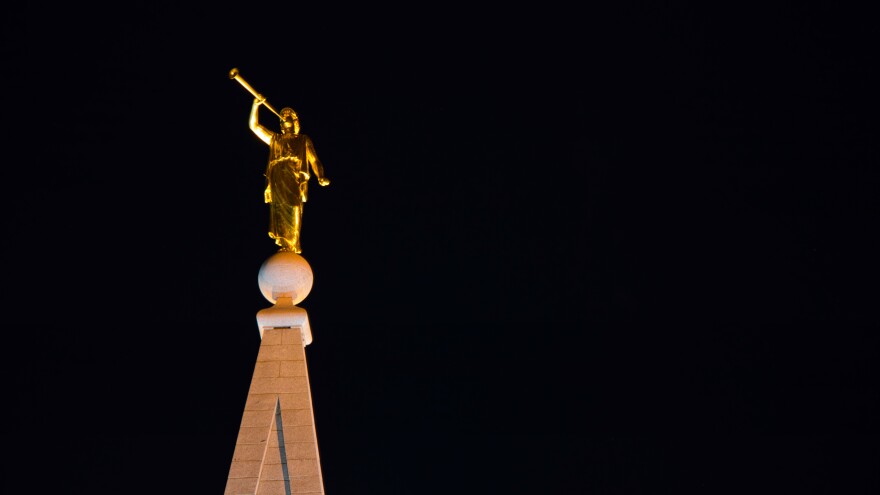In 1969, 14 Black football players at the University of Wyoming wanted to wear black armbands during their game against Brigham Young University. The idea was to protest The Church of Jesus Christ of Latter-day Saints’ policy at the time that barred Black men from the priesthood. But when the players asked for permission, they were dismissed from the team. Now, more than 50 years later, the Church has announced a partnership with the Black 14 Philanthropy to distribute food to various communities. Dr. LaShawn Williams, a social worker, a church member and co-founder of the group Black LDS Legacy, said she sees the move as a kind of “do-over” for the church.
This interview has been edited for length and clarity.
Caroline Ballard: This is not the first time The Church of Jesus Christ of Latter-day Saints has partnered with an organization that advocates for social and racial justice. It joined with the NAACP earlier this year to denounce racism. How do you view these kinds of efforts?
Dr. LaShawn Williams: There was a time not long after the issues with the Black 14 that there were discussions of an apology. The Black 14 had asked for an apology for the policy. And when the Church had the opportunity to apologize, it asked if the University of Wyoming or if the state of Wyoming was going to also apologize to the Black 14. And because that was not going to happen, the Church opted not to apologize. So I think this recent partnership is work to repair that missed opportunity.
CB: The Church reversed its policy that excluded Black men from the priesthood in 1978, but it has never formally apologized for that, in addition to not apologizing to the Black 14. So how far can partnerships with groups like these go?
LW: Well, you're looking at performative partnerships versus transformative partnerships and reconciliatory partnerships. This one is performative. It meets very significant basic needs for Black, brown [and] indigenous communities, which should always be happening and is part of a welfare mission for a church. And the question is, once the performative relationship is created, what does transformation look like? What does healing and reconciliation look like?
CB: You mention that it's a performative action. There was a lot of language around that this summer with people saying that performative allyship is not enough, that it's something to be criticized. Is there worth in something that you think is performative?
LW: I do. I think that we have to adjust, and we have to understand what it looks like to empower performance. When anyone studies a role to perform, they want it to be believable. The question becomes, is the role part of a character that you can actually adopt? So fortunately or not, everyone has to start somewhere, and that's an area where we can definitely apply some supportive pressure to make it happen.
CB: It's sort of like a fake it until you make it kind of a thing?
LW: Fake it until you're made accountable for what you're faking. Absolutely, yes.
CB: From your viewpoint, how much do partnerships like this one ripple through membership, top-down?
LW: They stand as a beacon and they stand as an opportunity that opens doors for conversations that we have not had before. I have to say that in the last two years, I've seen more progress than I could have anticipated or predicted. But I deeply appreciate it, and I'm willing to work with the Church as long as the Church is willing to continue this work.
I know it will be awkward. I know that we might stumble. I know that we might be scared to acknowledge some elements of our past because we're so focused on trying to have a better future. But there's a lot that says we must remember where we've been so we can more actively and authentically chart where we're going. And I hope that so many pieces of the Church, from the grassroots to the office buildings and the top floors of [those] buildings are able to work together to really continue to bring truth into the world stage.
CB: What do you think is next in conversations about racial justice within The Church of Jesus Christ of Latter-day Saints?
LW: If it's able to tap into its specific history as a marginalized group of people in the U.S. who have experienced exclusion, that can give the Church organizationally the stamina and the commitment to see some really hard conversations through. I think that there are opportunities for the Church to really reach out and look at the examples of other predominantly white congregations that have gotten involved in the work of racial justice to show up to those conversations.
I think the Church is uniquely positioned because of its experiences of injustice, being a religious minority in the country, that if it really could tap into that experience and that identity more consistently as opposed to conveniently — it would do a lot in its ability to really grow and to help affect change in the ways that matter as our society continues to work towards justice.




